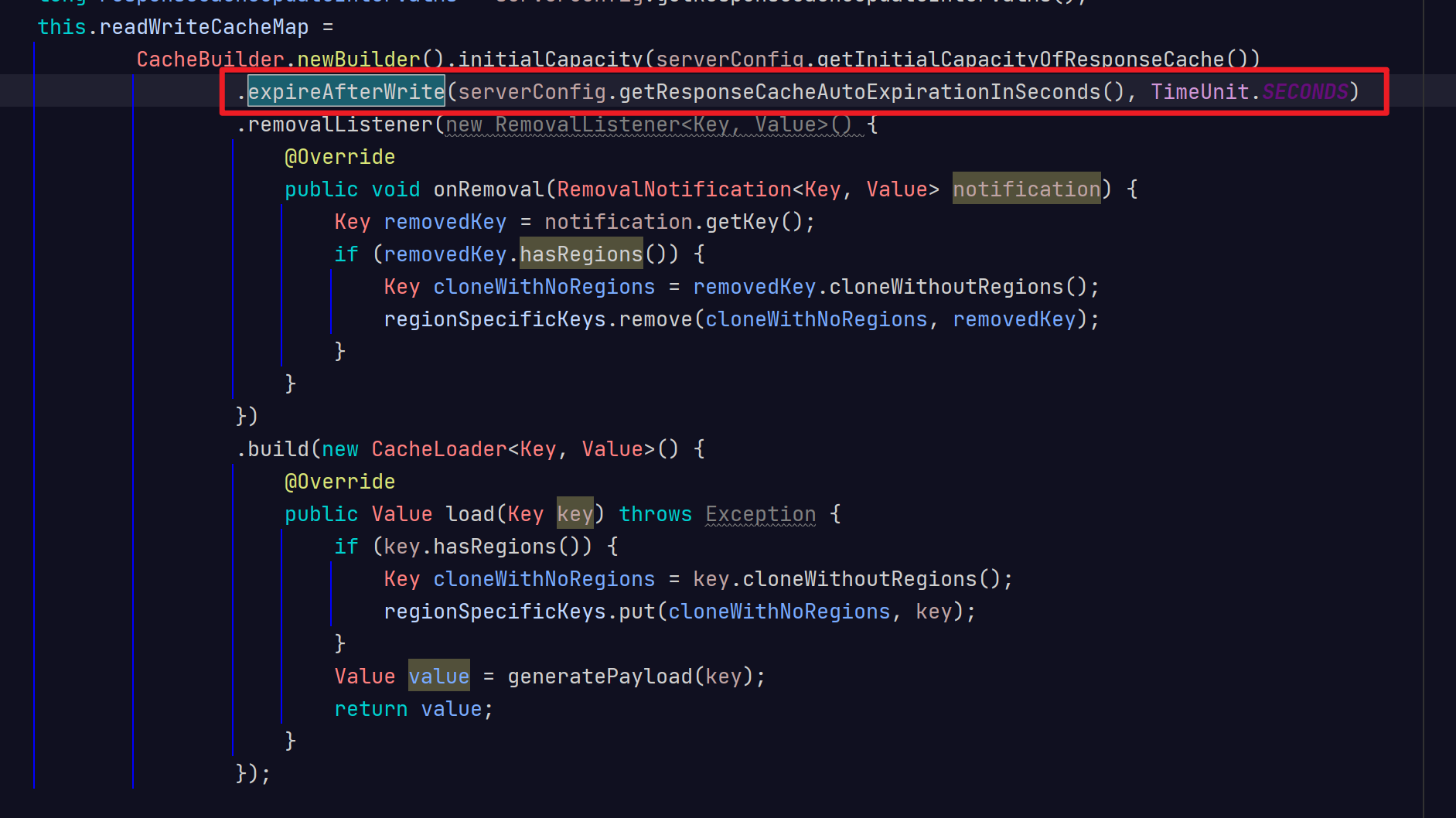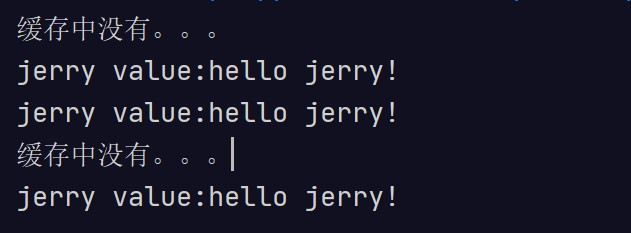Eureka Server的多级缓存和过期机制
多级缓存
之前写eureka-client客户端全量请求的时候,会走到缓存这边,下面就具体的看一下,server的多级缓存是怎么回事?
eureka client初始化的时候,就会自动发送个请求到eureka server拉一次清抓取全量的注册表,这一讲,我们来看看eureka server端如何处理抓取全量注册表的请求的,eureka client发送的请求是:http://localhost:8080/v2/apps/,get请求 ApplicationsResource的getContainers()方法,获取全量注册表的方法
com.netflix.eureka.registry.ResponseCache,响应缓存接口,接口代码如下:
public interface ResponseCache {
String get(Key key);
byte[] getGZIP(Key key);
void invalidate(String appName, @Nullable String vipAddress, @Nullable String secureVipAddress);
AtomicLong getVersionDelta();
AtomicLong getVersionDeltaWithRegions();
}com.netflix.eureka.registry.Key,缓存键。实现代码如下:
public class Key {
public enum KeyType {
JSON, XML
}
/**
* An enum to define the entity that is stored in this cache for this key.
*/
public enum EntityType {
Application, VIP, SVIP
}
/**
* 实体名
*/
private final String entityName;
/**
* TODO[0009]:RemoteRegionRegistry
*/
private final String[] regions;
/**
* 请求参数类型
*/
private final KeyType requestType;
/**
* 请求 API 版本号
*/
private final Version requestVersion;
/**
* hashKey
*/
private final String hashKey;
/**
* 实体类型
*
* {@link EntityType}
*/
private final EntityType entityType;
/**
* {@link EurekaAccept}
*/
private final EurekaAccept eurekaAccept;
public Key(EntityType entityType, String entityName, KeyType type, Version v, EurekaAccept eurekaAccept, @Nullable String[] regions) {
this.regions = regions;
this.entityType = entityType;
this.entityName = entityName;
this.requestType = type;
this.requestVersion = v;
this.eurekaAccept = eurekaAccept;
hashKey = this.entityType + this.entityName + (null != this.regions ? Arrays.toString(this.regions) : "")
+ requestType.name() + requestVersion.name() + this.eurekaAccept.name();
}
public Key(EntityType entityType, String entityName, KeyType type, Version v, EurekaAccept eurekaAccept, @Nullable String[] regions) {
this.regions = regions;
this.entityType = entityType;
this.entityName = entityName;
this.requestType = type;
this.requestVersion = v;
this.eurekaAccept = eurekaAccept;
hashKey = this.entityType + this.entityName + (null != this.regions ? Arrays.toString(this.regions) : "")
+ requestType.name() + requestVersion.name() + this.eurekaAccept.name();
}
@Override
public int hashCode() {
String hashKey = getHashKey();
return hashKey.hashCode();
}
@Override
public boolean equals(Object other) {
if (other instanceof Key) {
return getHashKey().equals(((Key) other).getHashKey());
} else {
return false;
}
}
}具体的缓存是在它的实现类ResponseCacheImpl中,在ResponseCacheImpl初始化的时候,就会定义一个readWriteCacheMap,指定它的一些策略。
ResponseCacheImpl(EurekaServerConfig serverConfig, ServerCodecs serverCodecs, AbstractInstanceRegistry registry) {
this.serverConfig = serverConfig;
this.serverCodecs = serverCodecs;
this.shouldUseReadOnlyResponseCache = serverConfig.shouldUseReadOnlyResponseCache();
this.registry = registry;
long responseCacheUpdateIntervalMs = serverConfig.getResponseCacheUpdateIntervalMs();
this.readWriteCacheMap =
CacheBuilder.newBuilder().initialCapacity(serverConfig.getInitialCapacityOfResponseCache())
.expireAfterWrite(serverConfig.getResponseCacheAutoExpirationInSeconds(), TimeUnit.SECONDS)
.removalListener(new RemovalListener<Key, Value>() {
@Override
public void onRemoval(RemovalNotification<Key, Value> notification) {
Key removedKey = notification.getKey();
if (removedKey.hasRegions()) {
Key cloneWithNoRegions = removedKey.cloneWithoutRegions();
regionSpecificKeys.remove(cloneWithNoRegions, removedKey);
}
}
})
//这里的话,就是如果在缓存中找不到的话,就会generatePayload从这里获取,抓取全量注册表,后面会单独写个demo测试一下。
.build(new CacheLoader<Key, Value>() {
@Override
public Value load(Key key) throws Exception {
if (key.hasRegions()) {
Key cloneWithNoRegions = key.cloneWithoutRegions();
regionSpecificKeys.put(cloneWithNoRegions, key);
}
Value value = generatePayload(key);
return value;
}
});
if (shouldUseReadOnlyResponseCache) {
timer.schedule(getCacheUpdateTask(),
new Date(((System.currentTimeMillis() / responseCacheUpdateIntervalMs) * responseCacheUpdateIntervalMs)
+ responseCacheUpdateIntervalMs),
responseCacheUpdateIntervalMs);
}
try {
Monitors.registerObject(this);
} catch (Throwable e) {
logger.warn("Cannot register the JMX monitor for the InstanceRegistry", e);
}
}下面的代码就是先走
public String get(final Key key) {
return get(key, shouldUseReadOnlyResponseCache);
}
@VisibleForTesting
String get(final Key key, boolean useReadOnlyCache) {
Value payload = getValue(key, useReadOnlyCache);
if (payload == null || payload.getPayload().equals(EMPTY_PAYLOAD)) {
return null;
} else {
return payload.getPayload();
}
}
@VisibleForTesting
Value getValue(final Key key, boolean useReadOnlyCache) {
Value payload = null;
try {
if (useReadOnlyCache) {
final Value currentPayload = readOnlyCacheMap.get(key);
if (currentPayload != null) {
payload = currentPayload;
} else {
payload = readWriteCacheMap.get(key);
readOnlyCacheMap.put(key, payload);
}
} else {
payload = readWriteCacheMap.get(key);
}
} catch (Throwable t) {
logger.error("Cannot get value for key : {}", key, t);
}
return payload;
}#get(key, useReadOnlyCache) 方法,读取缓存。其中 shouldUseReadOnlyResponseCache 通过配置 eureka.shouldUseReadOnlyResponseCache = true (默认值 :true ) 开启只读缓存。如果你对数据的一致性有相对高的要求,可以关闭这个开关,当然因为少了 readOnlyCacheMap ,性能会有一定的下降。
过期策略
主动过期


进行搜索一下,发现注册,下线、故障的时候,都会调用这个方法,那就去看一下这个方法到底做了什么

应用实例注册、下线、过期时,调用 ResponseCacheImpl#invalidate() 方法,主动过期读写缓存( readWriteCacheMap ),实现代码如下:
@Override
public void invalidate(String appName, @Nullable String vipAddress, @Nullable String secureVipAddress) {
for (Key.KeyType type : Key.KeyType.values()) {
for (Version v : Version.values()) {
invalidate(
new Key(Key.EntityType.Application, appName, type, v, EurekaAccept.full),
new Key(Key.EntityType.Application, appName, type, v, EurekaAccept.compact),
new Key(Key.EntityType.Application, ALL_APPS, type, v, EurekaAccept.full),
new Key(Key.EntityType.Application, ALL_APPS, type, v, EurekaAccept.compact),
new Key(Key.EntityType.Application, ALL_APPS_DELTA, type, v, EurekaAccept.full),
new Key(Key.EntityType.Application, ALL_APPS_DELTA, type, v, EurekaAccept.compact)
);
if (null != vipAddress) {
invalidate(new Key(Key.EntityType.VIP, vipAddress, type, v, EurekaAccept.full));
}
if (null != secureVipAddress) {
invalidate(new Key(Key.EntityType.SVIP, secureVipAddress, type, v, EurekaAccept.full));
}
}
}
}
public void invalidate(Key... keys) {
for (Key key : keys) {
logger.debug("Invalidating the response cache key : {} {} {} {}, {}",
key.getEntityType(), key.getName(), key.getVersion(), key.getType(), key.getEurekaAccept());
readWriteCacheMap.invalidate(key);
Collection<Key> keysWithRegions = regionSpecificKeys.get(key);
if (null != keysWithRegions && !keysWithRegions.isEmpty()) {
for (Key keysWithRegion : keysWithRegions) {
logger.debug("Invalidating the response cache key : {} {} {} {} {}",
key.getEntityType(), key.getName(), key.getVersion(), key.getType(), key.getEurekaAccept());
readWriteCacheMap.invalidate(keysWithRegion);
}
}
}
}将readWriteCacheMap中的ALL_APPS缓存key,对应的缓存给过期掉
被动过期
- 配置
eureka.responseCacheAutoExpirationInSeconds,设置写入过期时长。默认值 :180 秒。

定时刷新
初始化定时任务。配置 eureka.responseCacheUpdateIntervalMs,设置任务执行频率,默认值 :30 * 1000 毫秒。对比 readWriteCacheMap 和 readOnlyCacheMap 的缓存值,若不一致,以前者为主。通过这样的方式,实现了 readOnlyCacheMap 的定时过期。
if (shouldUseReadOnlyResponseCache) {
timer.schedule(getCacheUpdateTask(),
new Date(((System.currentTimeMillis() / responseCacheUpdateIntervalMs) * responseCacheUpdateIntervalMs)
+ responseCacheUpdateIntervalMs),
responseCacheUpdateIntervalMs);
}
private TimerTask getCacheUpdateTask() {
return new TimerTask() {
@Override
public void run() {
logger.debug("Updating the client cache from response cache");
for (Key key : readOnlyCacheMap.keySet()) {
if (logger.isDebugEnabled()) {
logger.debug("Updating the client cache from response cache for key : {} {} {} {}",
key.getEntityType(), key.getName(), key.getVersion(), key.getType());
}
try {
CurrentRequestVersion.set(key.getVersion());
Value cacheValue = readWriteCacheMap.get(key);
Value currentCacheValue = readOnlyCacheMap.get(key);
if (cacheValue != currentCacheValue) { //对比,如果不一致的话,将会读取读写缓存中的记录,将只读
readOnlyCacheMap.put(key, cacheValue);
}
} catch (Throwable th) {
logger.error("Error while updating the client cache from response cache for key {}", key.toStringCompact(), th);
} finally {
CurrentRequestVersion.remove();
}
}
}
};
}测试
@SneakyThrows
public static void main(String[] args) {
LoadingCache<String,String> cahceBuilder= CacheBuilder
.newBuilder()
.expireAfterWrite(2L, TimeUnit.SECONDS)
.build(new CacheLoader<String, String>(){
@Override
public String load(String key) throws Exception {
System.out.println("缓存中没有。。。");
String strProValue="hello "+key+"!";
return strProValue;
}
});
System.out.println("jerry value:"+cahceBuilder.get("jerry"));
System.out.println("jerry value:"+cahceBuilder.get("jerry"));
Thread.sleep(2000);
System.out.println("jerry value:"+cahceBuilder.get("jerry"));
}
最后
以上就是忧虑太阳最近收集整理的关于Eureka Server的多级缓存和过期机制的全部内容,更多相关Eureka内容请搜索靠谱客的其他文章。








发表评论 取消回复